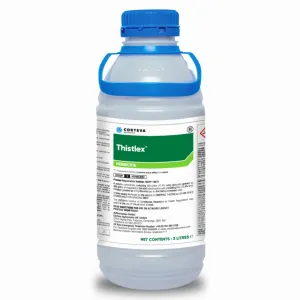You will need:
- Selective herbicide, e.g Vivendi
- Applicator (knapsack/boom sprayer)
- Correct PPE (overalls, rubber boots, chemical resistant gloves & face mask)
- Paddock soil analysis
- Recommended fertiliser (post soil test)
Problems Caused By Thistles:
The most commonly found thistle in a paddock is the creeping thistle. Creeping thistle spreads quickly due to its large spreading root system and can become well established in a very short space of time. They spread using lateral roots which are brittle and if broken can reshoot and form a new growth. Creeping thistle colonies can expand by as much as 6 to 12 m every year. As the roots can spread for a very large distance it can mean that large population clumps of thistles grown in certain areas can be attached to the same root system. As well as the roots being able to spread horizontally for long distances, they also have a tap root with grows Laterally making them more difficult to control should they become well established. Any seeds produced by the plant also germinate readily and particularly thrive in varying temperatures throughout the day.
Control:
The best time to treat Thistles is when they are actively growing in early spring/summer before they start to flower. Depending on weather factors thistles normally flower between July and September. As they can re-shoot from broken roots it is important that the thistle is killed down to the root leaving little chance of re-growth. Therefore it is often difficult to use non-chemical control methods such as digging the plant out as any damage caused to roots by a spade can promote regeneration.
The best selective weed killers to use are systemic ones and ones that contains Clopyralid, 24-D or Dicamba. To treat thistles and a range of other weeds such as Ragwort use Thrust. For well-established thistles use Vivendi which can be applied by either Knapsack or boom sprayer. For large areas use Thistle X which only has boom sprayer approval.
How To Prevent Future Spread of Thistles:
- Catch any signs of new growth early and treat with a selective herbicide.
- Weaken any established thistles by repeatedly cutting any top growth before any flower heads form.
- Prevent causing any damage to roots as this can cause re growth. If removing the roots try to remove the whole root in one go (this can be difficult to achieve due to the complicated root system)
- Maintain nutrient levels in the soil by fertilising. Carry out a soil analysis test to see if the field is depleted of nutrients.
We recommend using a systemic herbicide that contains Clopyralid, 24-D or Dicamba. We advise using either Thrust or Vivendi.
For more information on controlling thistles in a paddock, please get in touch with our sales team on 01522 246491.





